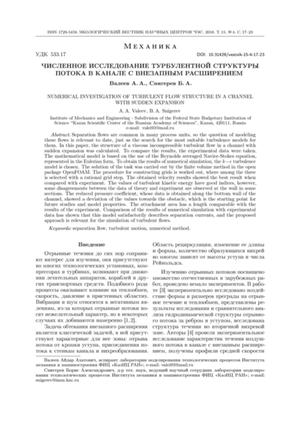Numerical investigation of turbulent flow structure in a channel with sudden expansion
UDC
533.17EDN
YRMLDFDOI:
10.31429/vestnik-15-4-17-23Abstract
Separation flows are common in many process units, so the question of modeling these flows is relevant to date, just as the search for the most suitable turbulence models for them. In this paper, the structure of a viscous incompressible turbulent flow in a channel with sudden expansion was calculated. To compare the results, the experimental data were taken. The mathematical model is based on the use of the Reynolds averaged Navier-Stokes equation, represented in the Eulerian form. To obtain the results of numerical simulation, the $k-\epsilon$ turbulence model is chosen. The solution of the task was carried out by the finite volume method in the open package OpenFOAM. The procedure for constructing grids is worked out, where among the three is selected with a rational grid step. The obtained velocity results showed the best result when compared with experiment. The values of turbulent kinetic energy have good indices, however, some disagreements between the data of theory and experiment are observed at the wall in some sections. The reduced pressure coefficient, whose data is obtained along the bottom wall of the channel, showed a deviation of the values towards the obstacle, which is the starting point for future studies and model properties. The attachment area has a length comparable with the results of the experiment. Comparison of the results of numerical simulation with experimental data has shown that this model satisfactorily describes separation currents, and the proposed approach is relevant for the simulation of turbulent flows.
Keywords:
separation flow, turbulent motion, numerical methodReferences
- Рейнольдс А.Дж. Турбулентные течения в инженерных приложениях. М.: Энергия: Москва, 1979. 406 c. [Reynolds A.J. Turbulentnye techeniya v inzhenernykh prilozheniyakh [Turbulent flows in engineering applications]. Moscow, Energiya Publ., 1979, 406 p. (In Russian)]
- Седов Л.И. Механика сплошной среды. В 2-х томах. СПб.: Лань, 2004. 1088 c. [Sedov L.I. Mekhanika sploshnoy sredy [Continuum mechanics]. St. Petersburg, Lan' Publ., 2004, 1088 p. (In Russian)]
- Терехов В.И., Ярыгина Н.И., Жданов Р.Ф. Особенности течения и теплообмена при отрыве турбулентного потока за уступом и ребром // Прикладная механика и техническая физика. 2002. Т. 43. № 6. С. 126–133. [Terekhov V.I., Yarygina N.I., Zhdanov P.F. Osobennosti techeniya i teploobmena pri otryve turbulentnogo potoka za ustupom i rebrom [Peculiarities of flow and heat transfer in the separation of a turbulent flow behind a ledge and an edge]. Prikladnaya mekhanika i tekhnicheskaya fizika [Applied Mechanics and Technical Physics], 2002, no. 6, pp. 126–133. (In Russian)]
- Егоров А.Г., Зоткин В.И., Иванин С.В. Исследование характеристик течения в канале с внезапным расширением // Авиационная и ракетно-космическая техника. 2008. № 3. С. 85–94. [Egorov A.G., Zotkin V.I., Ivanin C.V. Issledovaniye kharakteristik techeniya v kanale s vnezapnym rasshireniyem [Investigation of flow characteristics in a channel with sudden expansion]. Aviatsionnaya i raketno-kosmicheskaya tekhnika [Aviation and space-rocket technology], 2008, no. 3, pp. 85–94. (In Russian)]
- Kim J., Kline S.J., Johnson J.P. Investigation of a Reattaching Turbulent Shear Layer: Flow Over a Backward-Facing Step // Transactions of the ASME. 1980. Vol. 102. P. 302–308.
- Бубенчиков А.М., Фирсов Д.К., Котовщикова М.А. Численное решение плоских задач динамической вязкой жидкости методом контрольных объемов на треугольных сетках // Математическое моделирование. 2007. Т. 19. № 6. С. 71–85. [Bubenchikov A.M., Firsov D.K., Kotovshchikova M.A. Chislennoye reshcheniye ploskikh zadach dinamicheskoy vyazkoy zhidkosti metodom kontrol'nykh ob"yemov na treugol'nykh setkakh [Numerical reconstruction of plane problems of a dynamic viscous fluid by the method of control volumes on triangular grids]. Matematicheskoye modelirovaniye [Mathematical modeling], 2007, vol. 19 no. 6, pp. 71–85. (In Russian)]
- Фомин А.А., Фомина Л.Н. Численное решение задачи течения несжимаемой жидкости в плоском канале с обратным уступом при больших числах Рейнольдса // Вычислительная механика сплошных сред. 2017. Т. 10. № 3. С. 260–275. DOI: 10.7242/1999-6691/2017.10.3.21 [Fomin A.A., Fomina L.N. Chislennoye resheniye zadachi techeniya neszhimayemoy zhidkosti v ploskom kanale s obratnym ustupom pri bol'shikh chislakh Reynol'dsa [Numerical solutions of 2D steady incompressible backward-facing step flow at high Reynolds numbers]. Vychislitel'naya mekhanika sploshnykh sred [Computational continuum mechanics], 2017, no. 3, pp. 260–275. DOI: 10.7242/1999-6691/2017.10.3.21 (In Russian)]
- Жайнаков А.Ж., Калеева А.К., Курбаналиев А.Ы. Моделирование стационарных отрывных течений в пакете OpenFOAM // Математика, математическое моделирование и физика. 2014. № 32. № 3. С. 25–29. [Zhaynakov A.Zh., Kaleeva A.K., Kurbanaliev A.Y. Modelirovaniye statsionarnykh otryvnykh techeniy v pakete OpenFOAM [Simulation of stationary detached flows in the OpenFOAM package]. Matematika, matematicheskoye modelirovaniye i fizika [Mathematics, mathematical modeling and physics], 2014, no. 32, pp. 25–29. (In Russian)]
- Казанцев А.А., Анисонян В.Р. Моделирование 3D-течения CFD-кодом OpenFOAM // Известия вузов. Ядерная энергетика. 2010. № 4. С. 183–192. [Kazantsev A.A., Anisonyan V.R. Modelirovaniye 3D-techeniya CFD-kodom OpenFOAM [Modeling of the 3D-flow by CFD-code OpenFOAM]. Izvestiya vuzov. Yadernaya energetika [News of higher education institutions. Nuclear energy], 2010, no. 4, pp. 183–192. (In Russian)]
- Hackman L.P., Raithby G.D., Strong A.B. Numerical predictions of flows over backward-facing steps // International journal for numerical methods in fluids. 1984. Vol. 4. P. 711–724.
- Dong H., Li Z., Gao G., Shi Z., Guo J., Tang W. Numerical Investigation of Flow past a Backward-facing Step Using a Multi-scale Turbulence Model // Applied Mechanics and Materials. 2014. Vol. 654. P. 45–50. DOI:10.4028/www.scientific.net/AMM.654.45
- Weller H.G., Tabor G., Jasak H. A Tensorial Approach to Computational Continuum Mechanics Using Object Oriented Tecniques // Computers in Physics. 1998. Vol. 12. P. 620–631.
- Харламов С.Н. Алгоритмы при моделировании гидродинамических процессов. Томск.: ТПУ, 2008. 80 c. [Harlamov S.N. Algoritmy pri modelirovanii gidrodinamicheskikh protsessov [Algorithms for modeling hydrodynamic processes]. TPU, Tomsk, 2008, 80 p. (In Russian)]
Downloads

Downloads
Dates
Submitted
Accepted
Published
How to Cite
License
Copyright (c) 2018 Валеев А.А., Снигерев Б.А.

This work is licensed under a Creative Commons Attribution 4.0 International License.


